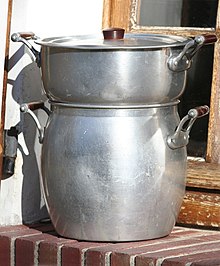Couscoussier
Ọdịdị

Nwanne nna ( ) bụ ngwa nri nwere ọnụ ụlọ abụọ nke ọdịnala a na-eji na North Africa na nri Berber (karịsịa, nri Libya, Tunisia, Algeria na Morocco) iji esi nri couscous..[1]
A na-ihe abụọ na-azụ ọnụ eme ya, nke e ji ma ọ bụ ụrọ omenala, ma ọ bụ ire (steel, Aluminum ma ọ bụ ọla kọpa mee). Nke mbụ, nke bụ nke ka ukwuu, na-ejide mmiri ma ọ bụ ofe eji ebe uzuoku. Nke abụọ, obere ite, a na-eme ka omume ya n'elu nke mbụ, ma nwee ụdị na ala nwere oghere, ka o wee jide couscous n'alụ ka ọ na-ekwe ka ịhụnanya banye ma banye n'ime ọka . Ozugbo esichara couscous, ikiri ike iji ite dị n'okpuru ya sie ma mezue isi ya, iji nye nri a ibure..[1][2]
Hụkwa
[dezie | dezie ebe o si]- Ndepụta nke arịa nri
Ihe odide
[dezie | dezie ebe o si]- ↑ 1.0 1.1 Fabricant (December 30, 1992). In the Land of Its Origin, Couscous Is More Than a Quick Fix. The New York Times. Retrieved on October 11, 2017.Fabricant, Florence (December 30, 1992). "In the Land of Its Origin, Couscous Is More Than a Quick Fix". The New York Times. Retrieved October 11, 2017. Kpọpụta njehie: Invalid
<ref>tag; name "nyt1" defined multiple times with different content - ↑ Franey. "Kitchen Equipment: Buying a Couscoussier", New York Times, February 20, 1980.
